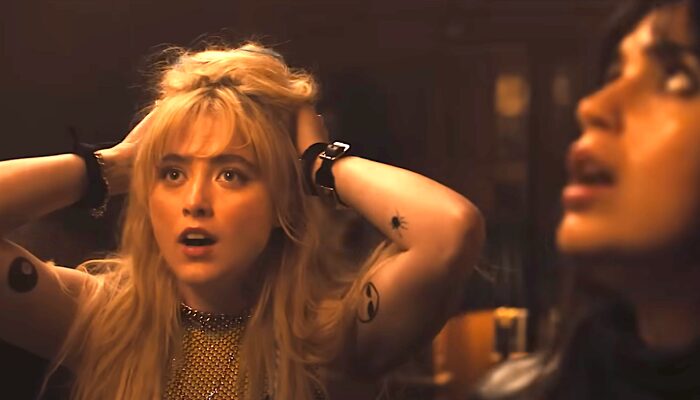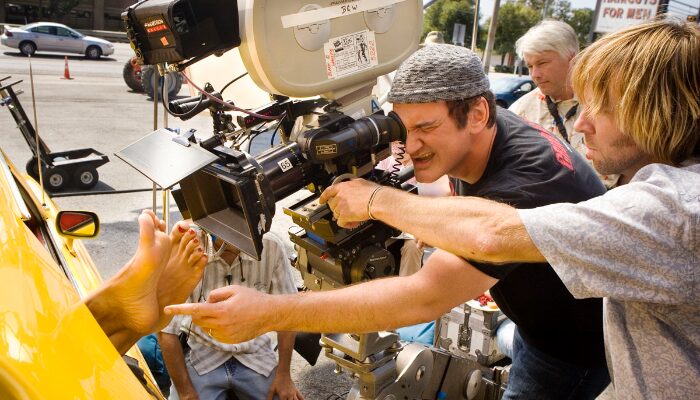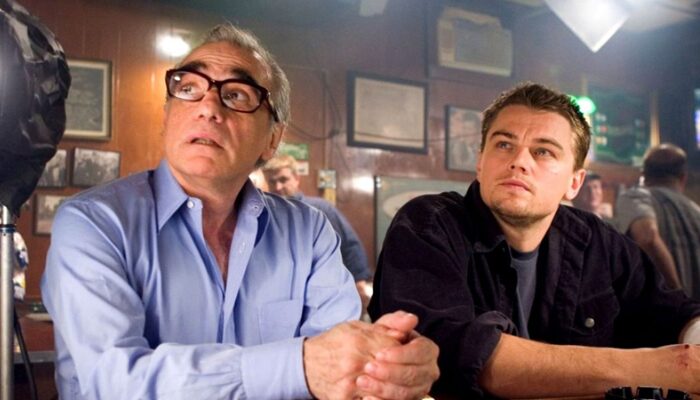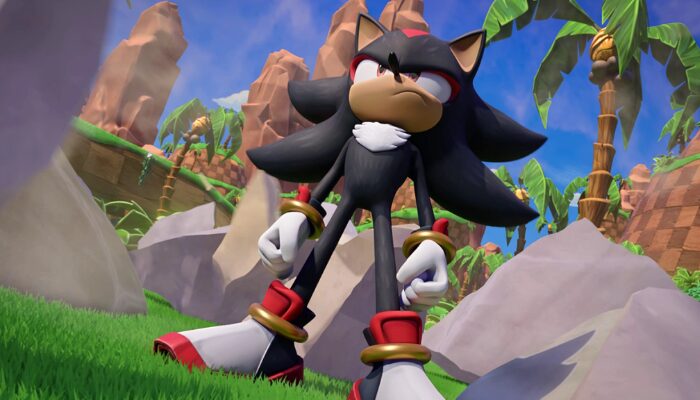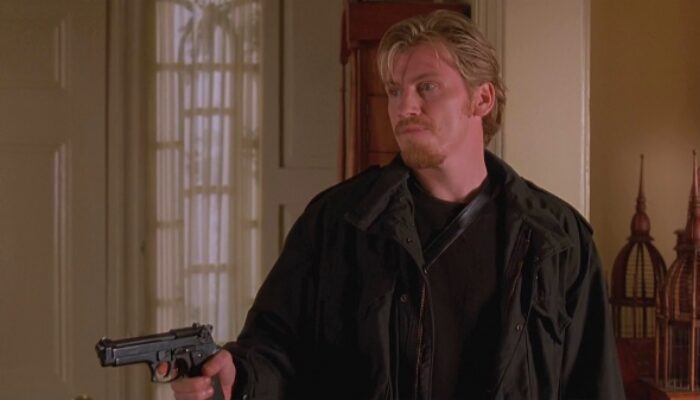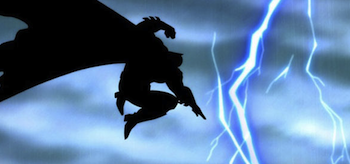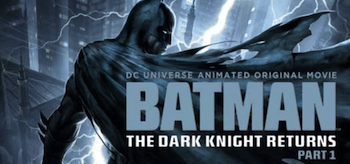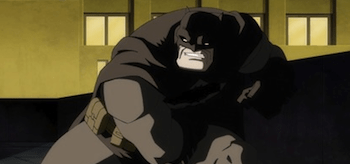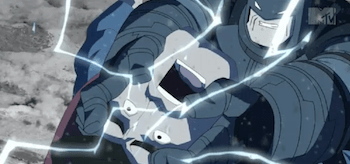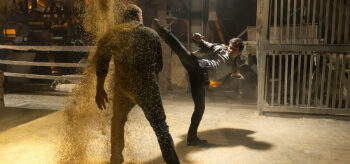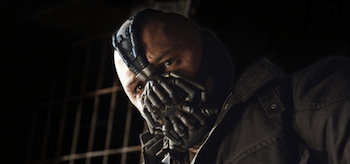Film Review: BATMAN: THE DARK KNIGHT RETURNS: Part 1 (2012)
Batman: The Dark Knight Returns: Part 1 (2012) Film Review, a movie directed by Jay Oliva and starring Ariel Winter, Peter Weller, Wade Williams, Michael McKean, Rob Paulsen, Maurice LaMarche, Gary Anthony Williams, David Selby, Maria Canals Barrera, and Gary Anthony Sturgis.
The Dark Knight Returns: Part 1 is the finest animated Batman film to date and is much better than any Tim Burton Batman film, any Joel Schmucacher Batman film, and Christopher Nolan’s The Dark Knight Rises. This film is so good it deserved a theatrical release, as Batman: Under The Red Hood almost deserved (the former completely over shadows the latter in everyway).
Writers Bob Goodman and director Jay Oliva paid attention to detail during their adaptation of Frank Miller’s seminal work, treating the source material as sacred. Comic book panels are directly translated onto the screen as are lines of dialogue, including the Mutant gang’s slang, Gotham City street lingo, and youth speak: “Pipe”, “Spud”, “Shiv”, “Billy”, “My mon licken chegs”, “Dusted”, et cetera.
The producers of The Dark Knight Returns: Part 1 also paid equal attention to the film’s score. I am guessing one of the most expensive aspects of the film, besides the Hollywood voice actors present, was the score for specific scenes and the overall film. Composer Christopher Drake realized that like the scores present in Robert Zemeckis’ Beowulf, Tim Burton’s Batman, John Milius’ Conan the Barbarian, and Christopher Nolan’s Inception, music can and does play a central role in scenes, in characters’ emotions, and assists in delivering a greater, dramatic impact. With that in mind, he set about creating music that accomplished those tasks and was successful.
Each key scene in The Dark Knight Returns: Part has its own unique sound: Harvey Dent (Wade Williams)’s heist, Mutant Leader (Gary Anthony Williams)’s first fight, Robin (Ariel Winter) helping an unconscious Batman (Peter Weller), Mutant Leader’s second fight, and the some of the news casts thoughout the film.
Moving from sound into visuals, the roof battle during the Harvey Dent’s heist was brillant and only Christopher Nolan has been able to capture anything approaching it during a live-action Batman movie. Watching Batman slip in and out of the fear toxin, beating down criminals or pulling them into the mist was like watching a Batman comic book come to life as it never has before.
For all of its excellence, The Dark Knight Returns: Part 1 is not without its flaws but it should be noted that many if not all of these flaws were carried over and unaltered from their comic book incarnation: The Mayor entering the cell of the unhandcuffed Mutant Leader by himself was lunacy unparalleled anywhere else in The Dark Knight Returns: Part 1 (including scenes in the booby hatch aka Arkham Asylum), Robin’s hand-to-hand combat skills coming out of nowhere (but watching her “assist” Batman as he battled the Mutant gang in the Batmobile was exhilarating), Batman walking down the hall of a US miltary base in plain view of everyone, and Batman sending a thirteen-year-old girl into the midst of the most violent and audacious street gang Gotham City has ever known. As a Mutant gang member says later in the film though: “Batman don’t shiv.”
Also curious was the fact that Bruce Wayne doesn’t alter his voice when he is Batman to disguise his identity. This was no more curious than the fact that the Gotham City Police Department lets every single member of the Mutant gang keep their shades while in lock up (a beautifully shot scene though, so I understand). Nolan did the same with The Joker in The Dark Knight when his make-up was not washed off for police photos and identification purposes yet used to create unease during the lamp scene between Comissioner Gordon and The Joker.
The viewer might also find it strange that Batman could take so many hits to his face during the first fight with the Mutant Leader (including a crowbar) yet have no bruising or welts on it afterward. The broken arm, robotic brace was dubious but no more so than Bruce Wayne’s bionic, no-knee-cartilage leg brace in The Dark Knight Rises.
Supporting these question marks and the remaining narrative in The Dark Knight Returns: Part 1 is history but not just Batman history, world history. Case and point: The Pearl Harbor reference. When Commissioner Gordon mentions President Eisenhower and the implication that he possibly knew about the attack on Pearl Harbor before it happened and that he and that issue were both too big for him to judge, Commissioner Gordon’s point completely alludes Police Captain Ellen Yindel (Maria Canals Barrera), eventhough it was meant as a reality check for her. She missed the allusion that Batman was a bigger issue than a vigilante fighting crime outside of the law, that his importance could not be realized or seen in the present. Batman is a stone dropped and Gotham City street history would be his ripples and jury.
This scene grounded the film and the legacy of Batman. It was one of the best dialogue scenes in the film. Almost as good was the dialogue: “This isn’t a mud hole. It’s an operating table and I’m the surgeon.” This was not only an instance of great dialogue but exciting dialogue. The words became as meaningful and brutal as the actions that followed them and set Batman apart from other superheroes. Very few superheroes have the savagery to ”break” an opponent the way in which Batman broke the Mutant Leader.
To do this aspect of the film and others justice, the violence had to be there and the viewer will be glad it wasn’t excluded as it has been in other comic-to-animated film adaptations.
Another theme that grounded The Dark Knight Returns: Part 1 in reality was the issue of the aging athlete. Like key characters in Darren Aronofsky’s The Wrestler and Black Swan, the age of the Batman present in The Dark Knight Returns: Part 1 alters the outcome of situations and altercations that would have turned out differently if he were younger e.g. the first fight with the Mutant Leader. The Mutant Leader even says as much, commenting during the fight that 55-year-old Batman is slow (“You slow Spud”). Unlike the live action Batmen, Batman’s brain in The Dark Knight Returns: Part 1 is his must valuable weapon and he uses that instument rather effectively the next time the Mutant Leader and he meet.
Two characters that didn’t meet in The Dark Knight Returns: Part 1 were Batman and The Joker. The Joker was not even mentioned by name in The Dark Knight Returns: Part 1 and is only seen a few times, a great story arc decision by the producers of the film. The Joker emerging from his catatonic state to remember his “darling” was an eerie way to end the film and fitting, especially with the music and the implications that followed this plot point.
Rating: 9.5/10
Related Articles
FilmBook's Newsletter
Subscribe to FilmBook’s Daily Newsletter for the latest news!

